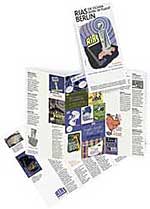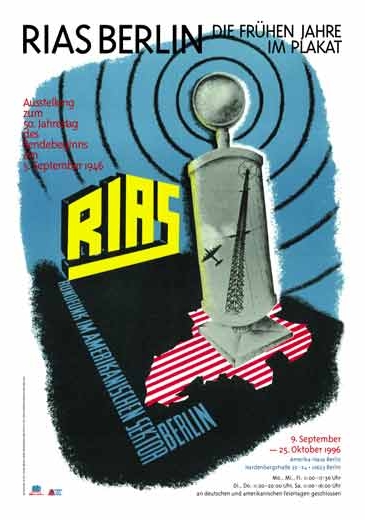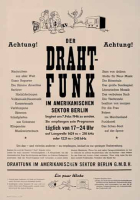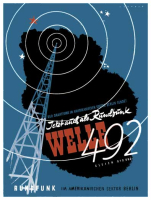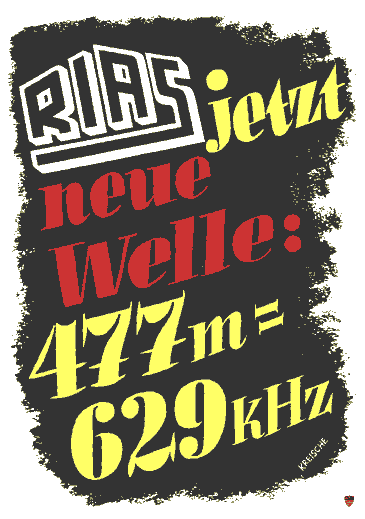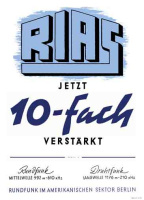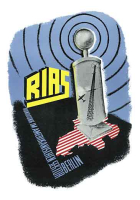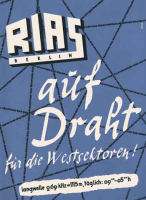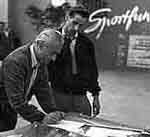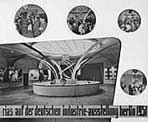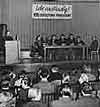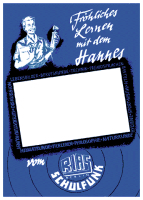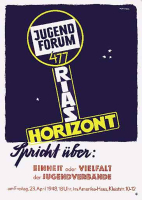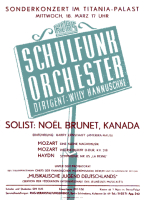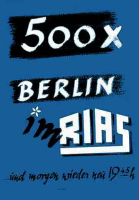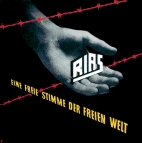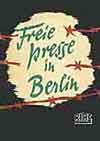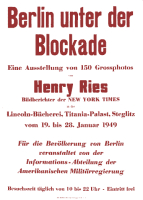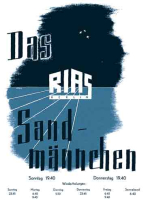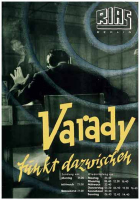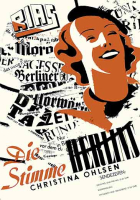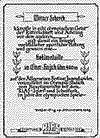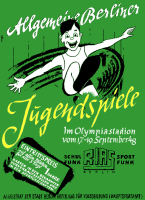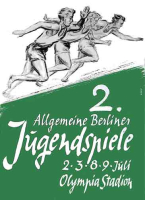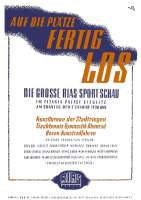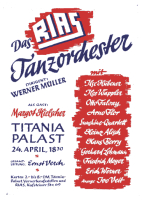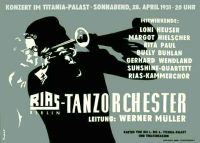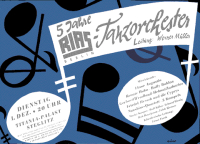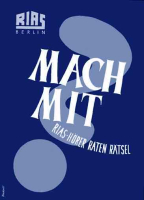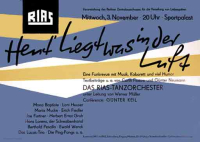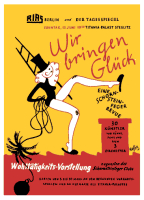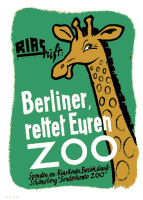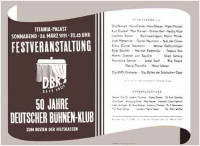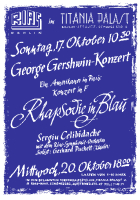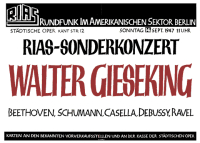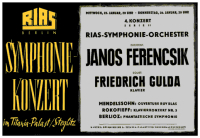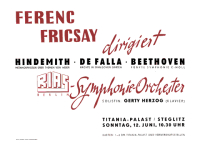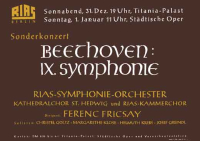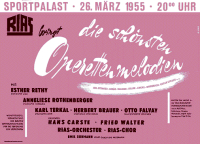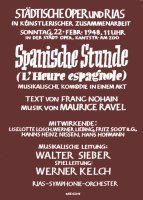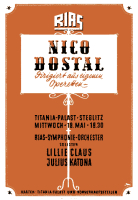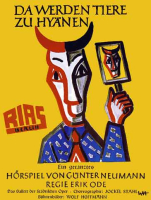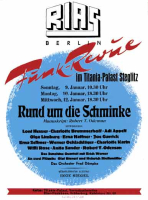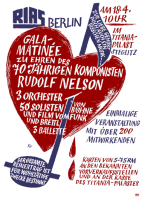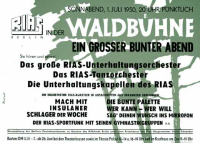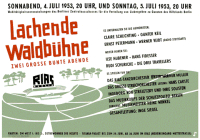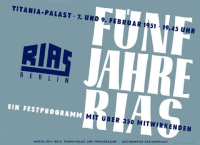RIAS BERLIN — THE EARLY YEARS IN POSTERS
An exhibition of posters from the first ten years of RIAS (1946–1955)
- A Poster Exhibition at Amerika Haus Berlin
September 9 – October 25, 1996
This exhibition of early posters in Amerika Haus Berlin was put together for the RIAS Berlin Commission in remembrance of RIAS (Radio in the American Sector), the radio station that started transmitting by wire to the American sector of occupied Berlin on February 7, 1946. It could be received on the air from September 5, 1946.
The exhibition brings to life a significant element of the history of both Berlin and the German-American relationship. RIAS Berlin was (and still is) a very important part of the life experience of many people, not only Berliners.
The more than 30 original posters, covering diverse themes, show what important role this station played in culture as well as in daily life in the postwar years. But most of all this station, with its fair style of journalism, contributed substantially to the formation of German democracy.
RIAS Berlin — the Early Years in Posters
1996 / Program folder
Design: Jack N. Mohr
RIAS Berlin – Die frühen Jahre im Plakat
1996 / DIN A1
Design: Jack N. Mohr
(using a graphic by his father, Günter Mohr from 1948)Idea, concept and design: Jack N.Mohr
Santa Barbara, KalifornienConceptual support: Petra Galle, Jutta Kroening
Berlin
EXHIBITION – TOPICS
- RIAS — a very Special Radio Station
With idealism and improvised technology — broadcasting for a new age
September 1946:
The first RIAS radio station, broadcasting on medium wave, was set up at a tree nursery in Britz. For weeks, everyone had to camp in a tent on sodden ground.
After all kinds of improvisation, RIAS gets its own broadcasting house in Schöneberg, Berlin. This was the home of RIAS Berlin, “the free voice of the free world” until it was wound up at the end of 1993.
In January 1946, posters in Berlin, a city ravaged by war, announced a new radio station: wire broadcasting in the American Sector. It had been set up by the Americans and was intended to be staffed exclusively by Germans reporting daily on current affairs.
After a very improvised start, a “proper” radio developed only seven months later on 5 September 1946. With only 800 watts of a pensioned-off transmitter to the troops, the radio in the American sector went on air for the first time on 492 kHz medium wave with an address given by the Governing Mayor of Berlin, Dr. Artur Werner. In March 1947, a new 2.5-kW transmitter went into service and in June of the same year the transmitter power was increased as much as tenfold. Frequency changes were, however, necessary.
In the difficult post-war years, and especially during the blockade, this radio station played a decisive role in people’s lives — not only in Berlin — as a source of information and the “free voice of the free world” RIAS had a dual role of preparing the way for democracy, culture and freedom of information and accompanying Germany on its journey from post-war reconstruction to reunification. Thus, in 1993 it had completed its task. With a commitment that lasted almost five decades, RIAS had helped to build up a solid bond of transatlantic friendship.
Achtung! Drahtfunk im amerikanischen Sektor Berlin
1946 / ca. DIN A3
Design: unknown
Drawings: Barlog
Drahtfunk im amerikanischen Sektor Berlin
Jetzt auch als Rundfunk Welle 492
1946 / ca. DIN A1
Design: Wolfgang Leopold
RIAS jetzt neue Welle: 477m = 629 kHz
1947? / ca. DIN A1
Design: Gerhard Kreische
RIAS jetzt 10-fach verstärkt
1947 / ca. DIN A1
Design: Rolf Schloesser
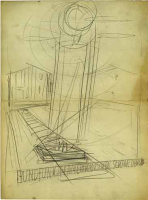
Rundfunk im amerikanischen Sektor Berlin
1948 / ca. DIN A3
Drawing and design: Günter Mohr
RIAS Berlin auf Draht für die Westsektoren!
1949 / ca. DIN A2
Design: Günter Mohr
- Graphic Artists who Worked for RIAS
The Radio Station’s Visible Side — Characterised by Creativity and Professionalism
designed the first poster in 1946 for RIAS, the Radio in the American Sector Berlin, (we are not counting the announcement of the wire broadcasting station in the American Sector Berlin — DIAS — in January 1946). It was most probably his first piece of work for RIAS. As far as we know, Wolfgang Leopold left Berlin shortly afterwards and moved to Düsseldorf.
Rolf Schloesser
designed not only a number of posters for RIAS in 1947 and 1948, but also the RIAS logo itself. To our knowledge, his design was chosen from a number submitted by Berlin graphic artists in response to an invitation to tender. Rolf Schloesser also moved to West Germany some time later.
Gerhard Kreische (Kr)
designed a series of posters for RIAS in 1947. He was commissioned mostly by RIAS (Office of the Military Government of the United States), the American authority that was still responsible at the time for publications. Gerhard Kreische later taught graphic art, in particular linocut and printing techniques, ultimately becoming professor at the Hochschule der Künste art school in Berlin.
Günter Mohr (GÜMO),
 born in 1923 in Potsdam, was from June 1948 to April 1950 the first graphic artist to have a permanent post with RIAS. Although he was actually a qualified architectural draughtsman, he had worked as a graphic artist for the American military authority, OMGUS Special Service, for a year. Through the large number of works he produced, not only posters but also brochures, advertising signs, stands at trade shows etc., this artist was largely responsible for RIAS’s image in the post-war years. In particular, his visual depiction of his subject matter is a striking contrast to the written posters that had been common until then. He also used photomontage and graphic art/photography combinations as stylistic tools for the first time for RIAS. His motif on a series of posters for symphonic concerts in the Titania-Palast continued to be used until the mid-fifties. GÜMO also worked for the radio station at a later date. In 1955, he designed his last poster for RIAS for Die schönsten Operettenmelodien (Finest operetta melodies) and subsequently emigrated to the U.S.A. There he worked first as a graphic artist in Seattle (Washington State) and then moved to the Container Corporation of America, where he became Senior Art Director West Coast in 1966. He later left the CCA, became professor at the famous California College of Arts and Crafts in Oakland, San Francisco and taught packaging design. In 1988, he died in Palo Alto, California after a prolonged illness.
born in 1923 in Potsdam, was from June 1948 to April 1950 the first graphic artist to have a permanent post with RIAS. Although he was actually a qualified architectural draughtsman, he had worked as a graphic artist for the American military authority, OMGUS Special Service, for a year. Through the large number of works he produced, not only posters but also brochures, advertising signs, stands at trade shows etc., this artist was largely responsible for RIAS’s image in the post-war years. In particular, his visual depiction of his subject matter is a striking contrast to the written posters that had been common until then. He also used photomontage and graphic art/photography combinations as stylistic tools for the first time for RIAS. His motif on a series of posters for symphonic concerts in the Titania-Palast continued to be used until the mid-fifties. GÜMO also worked for the radio station at a later date. In 1955, he designed his last poster for RIAS for Die schönsten Operettenmelodien (Finest operetta melodies) and subsequently emigrated to the U.S.A. There he worked first as a graphic artist in Seattle (Washington State) and then moved to the Container Corporation of America, where he became Senior Art Director West Coast in 1966. He later left the CCA, became professor at the famous California College of Arts and Crafts in Oakland, San Francisco and taught packaging design. In 1988, he died in Palo Alto, California after a prolonged illness.
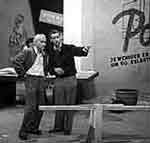
Günter Mohr (GÜMO, in both photos at the right),
1949, installing an exhibition at
the German Industrial Fair in Berlin
(the other person in the photo could not be identified)
and in the left photo with a typographic poster
for a Ferenc Fricsay concert
A display by Günter Mohr,
for the German Industrial Fair 1951
DAN (Max Danielsen?)
designed a number of posters for RIAS at the end of 1949. He was probably hired to take some of the pressure of work off GÜMO or cover for him during illness. He later worked in Hamburg as a graphic artist.
Johannes Rackau
became GÜMO’s successor at RIAS in 1950 and initially continued his graphic style. He remained at RIAS for ten years and then went to work at the European Union in Brussels as a graphic artist.
In the early years, Hans Kossatz and Wolff Hofmann also designed a number of individual posters, but this was probably outside the normal RIAS business. Other graphic artists who later worked for RIAS included Doris Metzler and Jutta Williams, and for a brief period Manfred Riewe. Others who were occasionally commissioned to design posters for RIAS included Albitz, Detlev (?) Bertram, Reinhart Braun, Peter Butschkow and Jack N. Mohr.
- Re-Education
Lessons in Democracy by Radio
A meeting of the RIAS schools radio parliament, 1948
Schools radio on RIAS in the early years after the Second World War, this was not only an attempt to provide teachers and parents with new teaching materials, but also an endeavour to rehearse the rules of democracy. Often working together with the Berlin government, known at the time as the Magistrat, RIAS initiated and followed up numerous activities which were considered to be a model for West German radio stations to follow:
- In 1948, the RIAS schools radio parliament was set up, consisting of elected pupils from all Berlin schools. It was also recognised as an advisory body to the schools department of the Berlin government.
- One year later, a group of interested pupils formed Humanitas, an academic society.
- In the same year, 1949, the RIAS schools radio orchestra, later to become the RIAS Youth Orchestra, was founded with Willy Hannuschke as its conductor. It has remained to this day the only radio orchestra for young people.
RIAS Schulfunk
Fröhliches Lernen mit dem Hannes
1948 / ca. DIN A2
Design: Günter Mohr
RIAS Schulfunk
Stundenplan
1948 / ca. DIN A2
Design: Günter Mohr
Jugend-Forum 477
RIAS Horizont
1948 / ca. DIN A1
Design: Gerhard Kreische
RIAS Schulfunk
Orchester
1952 / ca. DIN A2
Design: unknown
Current Affairs and Informative Journalism
Newscasts — Always Where the Action Is
Die neue Zeitung / Berliner Blatt of 3/13/1949:
„500 x Berlin on RIAS — The radio van
captures the voices of the city.“
Photo: Rissleben
RIAS reporters with their mobile van in front
of the Berlin Stadthaus on Parochialstrasse.
Photographer: unknown
From the very first day on air, current affairs were a firm part of RIAS’s programming. One of the first series on the wire broadcasting station was called “Our reporter”.
The Berlin election campaign in autumn 1946 made newscasts popular: excerpts from rallies, interviews with representatives of the parties and reports from the streets were the main ingredients of the programmes. The first regular series of newscasts on RIAS was christened “Berlin on RIAS” It developed into a democratic listeners forum — after 12 years of dictatorship, individuals were once more being asked for their opinions.
The practical challenges for the young reporters included the blockade, the currency reform, reports of assemblies of city representatives (where they were even physically attacked), division of the Berlin government into East and West, huge protest demonstrations outside the ruined Reichstag.
Ernst Reuter’s famous speech “A call to the world” also went out on a RIAS newscast. The 500th programme of “Berlin im RIAS” (Berlin on RIAS) was broadcast on 1 March 1949. In 1951, the character of the newscasts changed due to programming reforms. Classical newscasts now take pride of place, the days of improvisation are over. “Berlin im RIAS” is replaced by “Die Zeit im Funk” (Radio reflects the times).
500 x Berlin im RIAS
1949 / ca. DIN A2
Design: Günter Mohr
RIAS – eine freie Stimme der freien Welt
1950 / ca. DIN A3
Design: Johannes Rackau
- The Press Has the Microphone
Radio as a Forum for the Press
Cover of a brochure distributed free of charge by RIAS
containing manuscripts of the series Freie Presse in Berlin
(The free press in Berlin, 1949).
Design: Günter Mohr
Hans Herz, editor-in-chief and political director of RIAS until 1950, in the introduction to the brochure containing manuscripts of the series Freie Presse in Berlin: “In the part of Germany under Soviet occupation there is neither freedom of expression nor a free press. This means that almost 18 million Germans are not able to form an objective opinion for themselves based on uncensored newspapers. That was the main reason for us to give the free press in Berlin the opportunity to use our airwaves to speak to these Germans. At the same time, we want to provide active proof that in a free society the journalistic remit of both press and radio must have the same common goal.”
From 14 March to 2 May 1949, a total of eight programmes in the “Freie Presse” series were broadcast. The main themes were how Berlin journalists saw themselves at the time, the re-birth of the German press after 1946, dealings with the military authorities when applying for licenses, contemporary ideas and personal experience.
Journalists involved were: Maximilian Müller-Jabusch (Der Abend), Hans-Georg Otto (Das Montags- und Mittagsecho), Wilhelm Gries (Der Tag), Hellmut Meyer-Dietrich (Der Tagesspiegel), Walter Busse (Der Kurier), Arno Scholz (Der Telegraf), Andres Achenbach (Spandauer Volkblatt), Franz Tausch (Der Sozialdemokrat).
Berlin unter der Blockade
Henry Ries
1949 / ca. DIN A2
Design: unknown
Öffentliche Diskussion: Fragen Sie die 3 Parteien!
1949 / ca. DIN A2
Design: Günter Mohr
- Back-Talk
Cold War on the Radio
Cover of a brochure on RIAS’s political
programs and different listener reactions.
Design: Günter Mohr
In 1948, the year of the blockade, the Cold War also came to RIAS. In autumn 1947, the US military governor General Lucius D. Clay had given the starting signal to counter propaganda with “Operation Back-Talk”.
That meant abandoning the occupying powers’ orders to maintain peaceful relations, which the Americans had until then largely adhered to. Nevertheless, it took almost another year before the change in the American management of RIAS — the liberal American Ruth Norden took her leave — became noticeable in the programming.
From summer 1948, special series of programmes were initiated on RIAS that looked critically at the policies of the Soviet occupying power. Particularly popular were the 5-minute political satire spots that went out almost daily: “Varady funkt dazwischen” (Varady interrupts transmission), “Das Sandmännchen” (The Sandman) and “Die Stimme Berlins” (The voice of Berlin).
The early fifties also saw the rise to fame of Pinsel and Schnorchel; two East German officials — with their parodies about “Comradissimo Stalin” or the “worm-ridden circumstances in the GDR”.
Das Sandmännchen
1948/49 – ca. DIN A2
Design: Günter Mohr
Varady funkt dazwischen
1948 / ca. DIN A1
Design: Günter Mohr
Die Stimme Berlins – Christina Ohlsen
1948 / ca. DIN A2
Design: Günter Mohr
- Young People, Sports and Politics
In the Olympic Spirit
Gold-medallist Werner Schreck took the Olympic oath on behalf of the participants
in the “Allgemeine Berliner Jugendspiele” (Berlin Open Youth Games).
Design of the certificate: Günter Mohr
The first “Allgemeine Berliner Jugendspiele,” a forerunner to “Jugend trainiert für Olympia” (Young people training for the Olympics) took place in 1948 “in the Olympic spirit” At this point, occupied Germany was still excluded from the Olympic Games. At the same time, in the wake of the East-West conflict that was becoming more acute, RIAS stepped up its attempts to use young people with Western ideals to counter Communist policies: airtime for youth radio was increased, public discussion focused on the heated debate in Berlin as to whether other youth associations apart from the Freie Deutsche Jugend or FDJ (Free German Youth) led by Erich Honecker should be permitted.
The nationwide meeting of the FDJ in East Berlin and the World Youth Games the year after became — initially completely spontaneously — mass events at RIAS’s headquarters: thousands of young people from the GDR took the opportunity of visiting the radio station in the Western part of Berlin and talking with RIAS journalists and politicians such as Jakob Kaiser and Kurt Schumacher.
Allgemeine Berliner Jugendspiele
1948 / ca. DIN A2
Design: Günter Mohr
2. Allgemeine Berliner Jugendspiele
1949 / ca. DIN A2
Design: Günter Mohr
Auf die Plätze, fertig, los
1949 / ca. DIN A2
Design: Max Danielsen
- Dance Music on the Radio
and the RIAS Dance Band
Cover of the booklet that accompanied the program
‘Die RIAS-Tanzstunde’ (Dancing lessons with RIAS)
with illustrated instructions for different dances
ranging from the one step to the waltz to the samba.
Design: Günter Mohr
When the RIAS dance band (RIAS Tanzorchester or RTO) was founded at the end of 1948, their first task was to put together a repertoire of German dance and light music for radio. At the same time, RIAS’s rival in the Eastern part of the city, the Berliner Rundfunk, was enjoying success with its light music and with its dance band, the Radio Berlin Tanzorchester or Radio Berlin Dance Band. However, by 1950, when the East Berlin band was dissolved, many musicians had joined the RIAS dance band.
Modern dance and light music was initially something of a poor cousin at RIAS, but then under the direction of its conductor Werner Müller, it became a hallmark of the station. Then in the 1950s, the legendary Glenn Miller sound with its outstanding swing/jazz arrangements became popular once more with a new generation of listeners and enjoyed a revival.
Rock n’ roll also had its rightful place. The band went on tour, giving concerts in the Federal Republic of Germany, Europe and the U.S.A. Later, in the sixties and seventies, the RIAS dance band, led by Horst Jankowski, became well known through the major TV shows. The band is still in existence today: now called the RIAS Big Band, it is led by Jiggs Whigham and is a permanent fixture in the musical life of Berlin.
Das RIAS Tanzorchester im Titania-Palast
1948 / DIN A2
Design: Günter Mohr
Das RIAS-Tanzorchester
1951 / ca. DIN A1
Design: Johannes Rackau
Faschingskonzert
1953 / ca. DIN A1
Design: Johannes Rackau?
5 Jahre RIAS-Tanzorchester
1953 / ca. DIN A1
Design: Günter Mohr
- Quizzes and Games Shows
Escape from the Burdens of Everyday Life
The first president of the Federal Republic of Germany,
Theodor Heuss, at the 100th “Mach Mit” on 1st May 1951
at the Waldbühne open-air auditorium in Berlin.
With its diverse entertainment programme, RIAS became a forum for special talents and new experiments. From 1948, Werner Oehlschläger started to expand the entertainment department. The idea was to create a close link between the radio station and its listeners, which was in fact one of the characteristic features of the radio station until it closed down in December 1993.
Part of this was the programme “Mach mit” (Join in): the first programme was on 5 June 1948 in the Kleist hall in Schöneberg, headed by Ivo Veit and Wilhelm Ehlers. Only eight programmes based on the American show “Double or nothing” — were planned. In fact, over 140 were broadcast! The 100th programme came from the Waldbühne. The matchstick firework initiated by Ivo Veit was also lit there.
Hans Rosenthal is unmistakeably associated with RIAS’s entertainment programmes. After a brief guest appearance with Berliner Rundfunk, he moved to RIAS in 1946. The “Klingende Sonntagsrätsel,” “Die Rückblende,” “Wer fragt, gewinnt,” “Allein gegen alle” and “Dalli, dalli” were quiz shows that became famous throughout the land.
Apart from quiz shows and games shows, RIAS also organised charity events in conjunction with other Berlin media. These included the radio revue and political cabaret show “Heut’ liegt was in der Luft” (There’s something in the air today) in the Sportpalast or the “Schornsteinfeger-Revue” (Chimneysweeps’ revue) in the Titania-Palast.
Mach Mit
RIAS-Hörer raten Rätsel
1953? / ca. DIN A1
Design: Johannes Rackau
Heut’ liegt was in der Luft
1954 / ca. DIN A1
Design: Johannes Rackau
Wir bringen Glück
Schornsteinfeger-Revue
1953 / ca. DIN A1
Design: Hans Kossatz
- Help in Times of Need
A Radio Station Collects Donations
RIAS reporter Jürgen Graf and director of programmes Ruth Gambke present
mayor Louise Schröder with a cheque for over 15,000 DM for the Hilfswerk
Berlin charity from the proceeds of an event in the Waldbühne in July 1950.
Photo: Helmut Rudolph
The young radio station RIAS, shaped by people’s concerns, the political new-beginning and a broad spectrum of arts programmes, offered not only a range of programmes that reflected life in the immediate post-War period, but also organised appeals for charity, something which only a few radio stations continue to do today. Berlin’s zoo was severely damaged by bombs; only 90 animals survived the Second World War. Reconstruction proved very difficult and the Berlin blockade presented a new threat to the zoo.
RIAS helped out. Led by, Erik Ode, RIAS started an appeal: “RIAS Berlin calls out: Berliners save your zoo” An account was set up for donations to buy animal feed and fuel and after only a few weeks the zoo’s director Dr. Katharina Heinroth was able to receive a hefty sum of money.
RIAS BERLIN ruft: Berliner, rettet Euren Zoo
1949 / ca. DIN A2
Design: Günter Mohr
Berlin lebt, liebt und lacht
1949 / ca. DIN A2+
Design: Max Danielsen
50 Jahre Deutscher Bühnen-Klub
1951 / DIN A1
Design: unknown
- Music Amidst the Rubble
A Symphony Orchestra of World Renown
Ferenc Fricsay rehearsing with the RIAS Symphony Orchestra
Photo: Rudolph
Part of the unbelievable flourishing of cultural life in the city was the foundation of four RIAS orchestras within the first two years after the war. One of them still exists today the RIAS Symphony Orchestra.
Musicologist Prof. Elsa Schiller, who was in Theresienstadt concentration camp during the Nazi period, began her work with RIAS shortly after the end of the war and became head of the music department. She had excellent contacts to internationally recognised musicians and this had a broad and diverse influence on RIAS’s music programming.
She met the Hungarian conductor Ferenc Fricsay at a concert in Vienna and engaged him for RIAS in Berlin. Together, they ran the RIAS Symphony Orchestra and were able to appoint exceptional musicians for the orchestra. From 1948 to 1954 and 1958 to 1963, Ferenc Fricsay was chief conductor of the orchestra, which played mainly works by Jewish composers that had been banned for such a long time.
Thanks to their worldwide success, the orchestra was able to secure independent status for itself, which also guaranteed their international standing and their continued existence after German reunification under the name German Symphony Orchestra.
George Gershwin – Rhapsodie in Blau
(the first Gershwin concert in Germany)
1948 / ca. DIN A2
Design: Günter Mohr
RIAS Sonderkonzert Walter Gieseking
1947 / ca. DIN A1
Design: Gerhard Kreische
Richard Wagner-Konzert
RIAS-Symphonie-Orchester
1948 / ca. DIN A1
Design: Gerhard Kreische
RIAS Symphonie-Konzert
1948–1953 / ca. DIN A1
Design: Günter Mohr
Ferenc Fricsay dirigiert Hindemith
1948 / ca. DIN A1
Design: Günter Mohr
Sonderkonzert — Beethoven: IX. Symphonie
1949 / ca. DIN A1
Design: Günter Mohr?
Ferenc Fricsay dirigiert Johann Strauß
1951 / ca. DIN A1
Design: Johannes Rackau
RIAS bringt die schönsten Operettenmelodien
1955 / ca. DIN A1,
Design: Günter Mohr
Spanische Stunde
1948 / ca. DIN A1
Design: Gerhard Kreische
Nico Dostal dirigiert aus eigenen Opern
1949 / ca. DIN A2
Design: Max Danielsen
- With Wit and Humor
Satire on Stage and on the Radio
Rehearsals for the revue “Berlin-W-Weh”:
Erik Ode, Günter Neumann, Dora Paulsen, Rudolf Nelson
Photo: A. Bankhardt
Cover of the program for the revue “Berlin-W-Weh”.
Design: Walter Kolshorn
Topical revues and political satire were amongst the strongest crowd pullers in RIAS’s program, both everlastingly linked with the name Günter Neumann. This part of the programme was developed from 1948 onwards under the leadership of William F. Heimlich, a radio producer from Ohio, who was responsible for both Erik Ode and Werner Oehlschläger joining RIAS. He was subsequently head of entertainment for many years. Both men were friends of Günter Neumann’s and were part of the core group behind RIAS’s early political satire shows.
The early themes of the shows were Berlin life during the blockade, the art of survival, struggles for survival and the political climate in East and West. The radio play with dance “Da werden Tiere zu Hyänen” (It’s enough to make animals become hyenas) based on George Orwell’s “Animal Farm” was unmistakeably referring to the situation in the Soviet zone of occupation.
Finally, the collaboration with the composer Rudolf Nelson, who was still in exile in Holland, led to a gala matinee for his 70th birthday and, one year later, to the revue “Berlin-W-Weh” (book: Günter Neumann, music: Rudolf Nelson).
Da werden Tiere zu Hyänen
1948 / ca. DIN A1
Design: Wolf Hoffmann
Funk-Revue – Rund um die Schminke
1949 / ca. DIN A2
Design: Rolf Schloesser
Gala-Matinee zu Ehren des 70jährigen Komponisten Rudolf Nelson
1948 / ca. DIN A1
Design: Gerhard Kreische
- Fun and a Good Atmosphere
Entertainment Shows in Grand Style
A capacity audience at the Berlin Waldbühne open-air
theatre by night with the legendary matchstick fireworks.
(Archive photo)
The Titania-Palast and the Waldbühne were the venues for RIAS’s grand-scale entertainment shows. After surviving the blockade and the reconstruction work, relaxation and entertainment were the order of the day.
Anybody who was somebody appeared in the grand RIAS shows in the Waldbühne, which seated 18,000: the satirists from the “Insulaner”, popular artists from RIAS programs, singers and actors such as Vico Torriani, Heinz Erhardt, Claire Schlichting, Rudi Schuricke or the Drei Travellers. The various RIAS orchestras, along with the music corps of the police force, provided the musical setting.
Here too the proceeds went to charitable causes, since there was still a great deal of poverty and need in many areas of the city which was still suffering the after-effects of war.
RIAS in der Waldbühne
1950 / ca. DIN A1
Design: Johannes Rackau
Lachende Waldbühne
1951 / ca. DIN A1
Design: Johannes Rackau
Lachende Waldbühne
1953 / ca. DIN A1
Design: Johannes Rackau
Fünf Jahre RIAS — ein Festprogramm
1951 / ca. DIN A1
Design: Johannes Rackau

